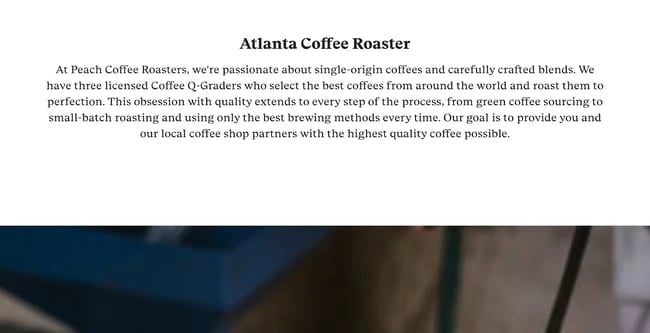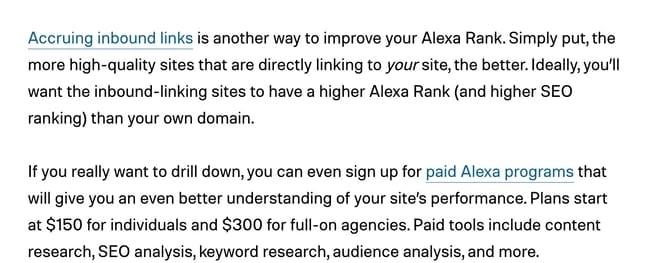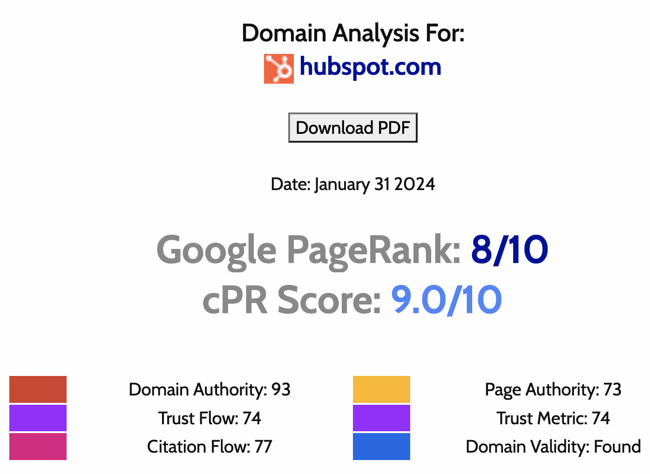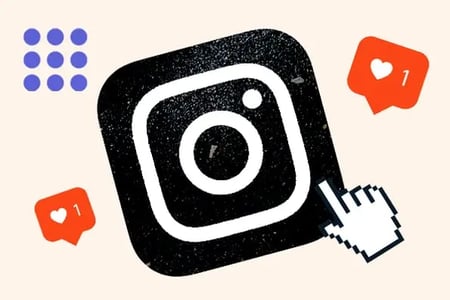MarketingInsights, ideas, and inspiration for modern marketers.
- English
- : Select a language
- High Contrast
- Log inStart free or get a demo
Blogs
Newsletters
Videos
Podcasts
Resources
HubSpot Products
Marketing
Insights, ideas, and inspiration for modern marketers.
Subscribe and stay up to date with the latest marketing tips and news.
Subscribe
5 Steps to Create an Outstanding Marketing Plan [Free Templa...
Creating a marketing plan? Learn how, plus get started with these free templates as a guide.
Rebecca Riserbato
Updated
1/4/24
Featured Articles

27 of the Best Professional Bio Examples I've Ever Seen [+ T...
Lindsay Kolowich Cox
Updated
12/20/23
The Social Media Content Calendar Template Every Marketer Ne...
Basha Coleman
Updated
11/22/23
How to Create a Social Media Calendar to Plan Your Content
Flori Needle
Updated
12/26/23
Latest articles
How to Use the SUBTRACT Function in Excel
- Mehedi Hasan Shoab
- Updated
- 2/7/24

The 15 Best WordPress Email Plugins in 2024
- Alex Girard
- Updated
- 6/7/22

SEO Step-by-Step Tutorial: 8 Easy Basics for Beginners to Ma...
- Mike Volpe
- Updated
- 2/7/24

The Hustle's YouTube Team Tells Us Their Favorite Short-Form...
- Erica Santiago
- Updated
- 2/6/24

24 of My Favorite Sample Business Plans & Examples For Your ...
- Clifford Chi
- Updated
- 2/6/24

Diving Deep Into Marketing in Financial Services (My Takeawa...
- Precious Oboidhe
- Updated
- 2/5/24
Artificial Intelligence
11 Artificial Intelligence Examples from Real Brands in 2023
- Kiran Shahid
- Updated
- 12/29/23

The Complete Guide to AI for Amazon Sellers in 2024
- Rachel Nicholson
- Updated
- 12/19/23

What's Holding AI Adoption Back in Marketing? [New Data]
- Kiara Taylor
- Updated
- 12/18/23

10 Challenges Marketers Face When Implementing AI in 2023 [N...
- Zoe Ashbridge
- Updated
- 12/11/23
Instagram Marketing
How to Use Instagram: A Beginner's Guide
- Caroline Forsey
- Updated
- 11/16/23

How to Gain Your First (or Next) 1,000 Instagram Followers -...
- Caroline Forsey
- Updated
- 1/16/24

When Is the Best Time to Post on Instagram in 2023? [Cheat S...
- Jana Rumberger
- Updated
- 7/31/23

How to Repost on Instagram: Ways to Reshare Content From Oth...
- Sophia Bernazzani Barron
- Updated
- 5/24/22
The State of Marketing Trends Report
The 2024 State of Marketing & Trends Report: Data from 1400+ Global Marketers
Discover the trends, tactics, and challenges marketers will focus on in 2023 and how they compare to today, according to 1,200+ global B2B & B2C marketers.
From HubSpot's video library
prev
next
How to Start Affiliate Marketing With No Experience or Money (4 Free Tools!)
- 13 min watch
- Updated
- 1/16/24
.jpg?height=240&name=YT_234_hubspot_v1%20(1).jpg)
How Khan Academy Broke the Education System
- 5 min watch
- Updated
- 1/12/24

Tips For Elevating Your Next Go-To-Market Strategy (+ Free Templates)
- 10 min watch
- Updated
- 1/10/24
.jpg?height=240&name=IMG_0735%20(1).jpg)
What Entrepreneurs Can Learn From Native Deodorant
- 4 min watch
- Updated
- 1/8/24

Growth Guide: How To Nail Your Product Line Extension
- 10 min watch
- Updated
- 1/1/24
.jpg?height=240&name=YT-237_A%20(1).jpg)
How to Start Affiliate Marketing With No Experience or Money (4 Free Tools!)
- 13 min watch
- Updated
- 1/16/24
.jpg?height=240&name=YT_234_hubspot_v1%20(1).jpg)
How Khan Academy Broke the Education System
- 5 min watch
- Updated
- 1/12/24

Tips For Elevating Your Next Go-To-Market Strategy (+ Free Templates)
- 10 min watch
- Updated
- 1/10/24
.jpg?height=240&name=IMG_0735%20(1).jpg)
What Entrepreneurs Can Learn From Native Deodorant
- 4 min watch
- Updated
- 1/8/24

Growth Guide: How To Nail Your Product Line Extension
- 10 min watch
- Updated
- 1/1/24
.jpg?height=240&name=YT-237_A%20(1).jpg)
How to Start Affiliate Marketing With No Experience or Money (4 Free Tools!)
- 13 min watch
- Updated
- 1/16/24
.jpg?height=240&name=YT_234_hubspot_v1%20(1).jpg)
How Khan Academy Broke the Education System
- 5 min watch
- Updated
- 1/12/24

Tips For Elevating Your Next Go-To-Market Strategy (+ Free Templates)
- 10 min watch
- Updated
- 1/10/24
.jpg?height=240&name=IMG_0735%20(1).jpg)
What Entrepreneurs Can Learn From Native Deodorant
- 4 min watch
- Updated
- 1/8/24

Growth Guide: How To Nail Your Product Line Extension
- 10 min watch
- Updated
- 1/1/24
Marketing Strategy
The 2024 State of Marketing & Trends Report: Data from 1400+...
- Maxwell Iskiev
- Updated
- 7/1/22

The Ultimate Guide to Marketing Strategies & How to Improve ...
- Elissa Hudson
- Updated
- 5/13/22

What is a Marketing Plan & How to Write One [+Examples]
- Clifford Chi
- Updated
- 12/27/23

8 Steps to Create a Complete Marketing Strategy in 2023
- Kayla Carmicheal
- Updated
- 10/26/23
From the HubSpot Podcast Network
prev
next
- Marketing Against the Grain
-min.png?height=240&name=MAT%20-%20Show%20Tile%203000x3000%20(1)-min.png)
AI Built A Free Growth Tool For Zapier In Under 2 Hours with Christopher Miller: VP of Growth and AI at HubSpot
- 28 min listen
- Updated
- 10/31/23
- Goal Digger Podcast
.png?height=240&name=PodcastCovers23%20(19).png)
Why Is NO ONE Doing These 5 Marketing Tactics?!
- 30 min listen
- Updated
- 11/1/23
- This Old Marketing
-3.png?height=240&name=PodcastCovers23%20(2)-3.png)
A Media Business Dumpster Fire
- 21 min listen
- Updated
- 11/1/23
- Create Like the Greats
%20copy-1.png?height=240&name=PodcastCovers23%20(2)%20copy-1.png)
How I Use AI to Drive Better ROI as a Marketer
- 16 min listen
- Updated
- 11/1/23
- Online Marketing Made Easy
-min.png?height=240&name=PodcastCovers23%20(6)-min.png)
3 Funnels That Have Made Millions In My Business
- 32 min listen
- Updated
- 11/1/23
- Inclusion and Marketing
-min.png?height=240&name=PodcastCovers23%20(4)-min.png)
Do this to increase customer acquisition for people from underrepresented and underserved communities
- 53 min listen
- Updated
- 11/1/23
- Marketing Against the Grain
-min.png?height=240&name=MAT%20-%20Show%20Tile%203000x3000%20(1)-min.png)
AI Built A Free Growth Tool For Zapier In Under 2 Hours with Christopher Miller: VP of Growth and AI at HubSpot
- 28 min listen
- Updated
- 10/31/23
- Goal Digger Podcast
.png?height=240&name=PodcastCovers23%20(19).png)
Why Is NO ONE Doing These 5 Marketing Tactics?!
- 30 min listen
- Updated
- 11/1/23
- This Old Marketing
-3.png?height=240&name=PodcastCovers23%20(2)-3.png)
A Media Business Dumpster Fire
- 21 min listen
- Updated
- 11/1/23
- Create Like the Greats
%20copy-1.png?height=240&name=PodcastCovers23%20(2)%20copy-1.png)
How I Use AI to Drive Better ROI as a Marketer
- 16 min listen
- Updated
- 11/1/23
- Online Marketing Made Easy
-min.png?height=240&name=PodcastCovers23%20(6)-min.png)
3 Funnels That Have Made Millions In My Business
- 32 min listen
- Updated
- 11/1/23
- Inclusion and Marketing
-min.png?height=240&name=PodcastCovers23%20(4)-min.png)
Do this to increase customer acquisition for people from underrepresented and underserved communities
- 53 min listen
- Updated
- 11/1/23
- Marketing Against the Grain
-min.png?height=240&name=MAT%20-%20Show%20Tile%203000x3000%20(1)-min.png)
AI Built A Free Growth Tool For Zapier In Under 2 Hours with Christopher Miller: VP of Growth and AI at HubSpot
- 28 min listen
- Updated
- 10/31/23
- Goal Digger Podcast
.png?height=240&name=PodcastCovers23%20(19).png)
Why Is NO ONE Doing These 5 Marketing Tactics?!
- 30 min listen
- Updated
- 11/1/23
- This Old Marketing
-3.png?height=240&name=PodcastCovers23%20(2)-3.png)
A Media Business Dumpster Fire
- 21 min listen
- Updated
- 11/1/23
- Create Like the Greats
%20copy-1.png?height=240&name=PodcastCovers23%20(2)%20copy-1.png)
How I Use AI to Drive Better ROI as a Marketer
- 16 min listen
- Updated
- 11/1/23
- Online Marketing Made Easy
-min.png?height=240&name=PodcastCovers23%20(6)-min.png)
3 Funnels That Have Made Millions In My Business
- 32 min listen
- Updated
- 11/1/23
- Inclusion and Marketing
-min.png?height=240&name=PodcastCovers23%20(4)-min.png)
Do this to increase customer acquisition for people from underrepresented and underserved communities
- 53 min listen
- Updated
- 11/1/23
More content
Visit the HubSpot blogs
 Sales
Sales- Best practices and examples of how to sell smarter
 Service
Service- Expert tips on how to build a customer-first organization
 Website
Website- Tips and tutorials on how to build better websites
 The Hustle
The Hustle- Insights to help you make smarter business decisions
 Next in AI
Next in AI- Your resource for the latest AI news and its impact on your business
 Sales
Sales- Best practices and examples of how to sell smarter
 Service
Service- Expert tips on how to build a customer-first organization
 Website
Website- Tips and tutorials on how to build better websites
 The Hustle
The Hustle- Insights to help you make smarter business decisions
 Next in AI
Next in AI- Your resource for the latest AI news and its impact on your business
 Sales
Sales- Best practices and examples of how to sell smarter
 Service
Service- Expert tips on how to build a customer-first organization
 Website
Website- Tips and tutorials on how to build better websites
 The Hustle
The Hustle- Insights to help you make smarter business decisions
 Next in AI
Next in AI- Your resource for the latest AI news and its impact on your business
HubSpot Blog
Subscribe to our Blogs
Pick the blog emails you want to receive.
Marketing
Sales
Service
Website
AI
Email address
Subscribe
We're committed to your privacy. HubSpot uses the information you provide to us to contact you about our relevant content, products, and services. You may unsubscribe from these communications at any time. For more information, check out our privacy policy.
Popular Features
- All Products and Features
- Free Meeting Scheduler App
- HubSpot AI Tools
- Email Tracking Software
- AI Content Writer
- AI Website Generator
- Email Marketing Software
- Lead Management Software
- AI Email Writer
- Free Website Builder
- Sales Email Templates
- Free Online Form Builder
- Free Chatbot Builder
- Free Live Chat Software
- Marketing Analytics
- Free Landing Page Builder
- Free Web Hosting
Free Tools
- Website Grader
- Make My Persona
- Email Signature Generator
- Brand Kit Generator
- Blog Ideas Generator
- Invoice Template Generator
- Marketing Plan Generator
- Free Business Templates
- Guide Creator
- Software Comparisons Library
- Template Marketplace
- Campaign Assistant
Company
Customers
Partners
- All Partner Programs
- Solutions Partner Program
- App Partner Program
- HubSpot for Startups
- Affiliate Program
- Youtube
- Medium
- Tiktok
Copyright © 2024 HubSpot, Inc.
- English
- : Select a language
- High Contrast
- Log inStart free or get a demo
Blogs
Newsletters
Videos
Podcasts
Resources
HubSpot Products
SEO Step-by-Step Tutorial: 8 Easy Basics for Beginners to Master
Published: February 07, 2024
You want to learn about search engine optimization (SEO), but where do you start? You’ve probably heard of a few basic terms, like keyword research, but what else do you need to know?

I this post, I'll walk you through the basic vocabulary you need to know and tips for learning SEO on your own. Then, we'll review a step-by-step SEO tutorial to help you get your SEO strategy off the ground.
Table of Contents
- SEO Basics
- How to Learn SEO
- SEO Step-by-Step Tutorial
→ Download Now: SEO Starter Pack [Free Kit]
SEO Basics
Having an understanding of foundational SEO vocabulary is important. Let’s dive into a few key words to know:
- Search Engine Optimization (SEO): The tactics you use to optimize your website to ensure you provide the high-quality information searchers look for and rank higher in search results for specific keywords so people can find your content.
- On-page SEO: Any optimizations you’d make within your website to improve search rankings, like the keywords used in your content or back-end elements like site structure.
- Off-page SEO: Any actions you take to improve your search engine rankings outside your website, like backlinks from other websites or guest blogging.
- Link building: Getting links to your website from other high-quality websites to build authority and credibility.
- SERPs: SERPs stands for Search Engine Result Pages, and it’s the results page after someone conducts a search.
- White-hat SEO: Optimization tactics that align with accepted and recognized best practices.
- Black-hat SEO: Optimization tactics that manipulate search engine algorithms to rank websites higher in SERPs. These tactics are often unethical.
- E-E-A-T: E-E-A-T stands for experience, expertise, authoritativeness, and trust. It’s part of Google’s Search Quality Rater Guidelines and one of the factors Google uses to determine a page's relevance and authority.
- Keyword: Words or phrases users type into a search engine to find content related to their search. As an SEO, you include relevant keywords in your content that align with search intent so your site appears in related searches.
- Keyword Research: The process of finding keywords people enter into search results related to your business to help you inform the words to use in your website pages and content.
- Organic/Organic results: Any results in SERP that are unpaid and that appear because of a page’s relevance to the search query.
- Organic traffic: Organic traffic is traffic that comes from organic results.
- Rank/page ranking: Where your site falls in SERPs for a specific keyword.
- Ranking factor: A ranking factor is an element that impacts where your site may fall in search results, like your page authority.
- >Search intent:Search intent is why a user conducts a search.
How to Learn SEO
We’ve just reviewed some basic terms, but now you want to dive deeper.
Learning SEO on your own is possible, but it’ll take a bit of time because there is a lot to learn. Thankfully, there’s so much helpful information out there to support you in your learning process.
I know everyone has a different learning style, so I’ll include resources that appeal to different needs.
1. Read and watch reliable resources.
There are a lot of educational resources out there to read and watch that will help you build your knowledge of SEO. Here are some of my recommendations.
- The HubSpot Blog (we cover a variety of topics for different skill levels)
- The HubSpot YouTube Channel
- Search Engine Journal
- Search Engine Land
- SEMrush
- Bing Webmaster Guidelines
There are other search engines out there, but I’m going to assume you’re mainly optimizing your website to meet Google’s quality standards. Therefore, the best and most reliable resource to learn to optimize for Google is, well, Google. The Search Central Blog and Search Quality Rater Guidelines are great places to start.
2. Take free courses.
If you benefit from structured and guided learning, an SEO course is another option to build on your SEO skills. A bonus is that many courses offer certificates upon completion. These are some high-quality options:
- HubSpot Academy SEO Training Certification (free): Best for beginners
- Google Analytics Academy (free): Beginner and advanced learning paths
- MOZ Academy (paid): Courses for multiple levels
- Semrush Academy (free): Courses for multiple levels
3. Stay on top of the trends.
SEO is always evolving, algorithms are always updated, and new trends are always coming about. For example, Google only recently added an E for Experience to the existing E-E-A-T guidelines to ensure that content is helpful, relevant, and created by someone with experience in the subject at hand.
This change is even more important as AI-generated content becomes more popular as the lived experience of a writer is a key differentiator between computers and humans.
Therefore, one of the most important factors in becoming an SEO expert is staying on top of the trends so you can pivot when major industry shifts happen. We cover changes in the SEO landscape on the HubSpot Blog, and Google also maintains a running list of major updates that can impact your SEO success.
4. Study your competitors.
Learning from your competitors is a great way to understand what’s helping other sites succeed.
You can conduct a competitor analysis to uncover things like new keywords to leverage, where competitors get backlinks from, and new opportunities to capitalize on.
Featured Resource: Our free Competitive Analysis Templates help you conduct a thorough analysis of competitors in your niche, and this step-by-step guide walks you through the process of using the template for an SEO competitive analysis.
5. Learn by doing.
Once you feel confident, you can take a hands-on approach with what you’ve learned and enact some SEO strategies.
If you already have a website, you can practice by doing something like a competitor analysis
and updating your current strategy based on your findings. If you don’t have a website, consider starting one, implementing some of your learnings, and monitoring metrics to see how you get on.
One of the best things about SEO is that a wide variety of tools are available to help you along every step of the way.
6. Use SEO tools.
Considering the breadth and depth of the internet, it would be a nightmare to do some of the essential SEO functions by hand — this is where SEO tools come in to save the day. They’ve saved me significant time and energy and quickly brought me the results I’m looking for.
Here’s a list of tools I recommend:
- HubSpot’s SEO Marketing Software: offers SEO recommendations to improve your site, optimize page content, and measure ROI.
- Website Grader: scores your site based on factors like mobile friendliness and SEO optimization.
- Google’s Search Console: can help you measure your site traffic and fix SEO performance issues.
- Google Analytics: helps you view important metrics to understand your SEO efforts, like the measure of organic vs non-organic traffic.
- Check Page Rank: monitors your website’s rank and domain authority
- Ahrefs: helps you conduct keyword research and stats their important stats like search volume and CTR
- Seobility: analyzes the technical aspects of your site to help you resolve on-page SEO issues
- Jasper: AI writing assistant that can help you write SEO-optimized blog posts with target keywords.
Once you’ve embarked on your learning journey and feel ready to jump in, here’s an easy step-by-step SEO tutorial to follow.
SEO Step-by-Step Tutorial
- Step 1: Find keywords.
- Step 2: Put keywords in the page title.
- Step 3: Put keywords in the page URL.
- Step 4: Put keywords in your meta description.
- Step 5: Put keywords in your H1 text.
- Step 6: Use keywords in the page’s content.
- Step 7: Build links to your website.
- Step 8: Monitor your rank.
1. Find keywords.
Keyword research is as simple as picking a list of words and phrases relevant to your business. Think about which words are most likely to get people to do what you want them to do (visit your website and submit a form) and focus on those words.
I've found that a dedicated keyword research tool, can be extremely helpful but, as a beginner, you can also intuitively choose your keywords first. For instance, if you sell roasted coffee, you might opt for “roasted coffee,” “Colombian coffee,” and “local coffee roaster.”
 Keyword Research Template
Keyword Research Template
Build your SEO strategy with this free template.
- Search Volume
- CPC
- Ranking
Keyword Difficulty
Download the Free Template
Learn more
List these keywords out in a spreadsheet or document for you to keep track of. Then, pick one word or phrase to use on one page of your site. In other words, you don’t want to target different keywords on one page. You want to target one keyword, as well as any keywords it’s semantically related to.
Continuing with the example from above, I might create a page for “local coffee roaster.” That would be my main keyword, but I can also target semantically related terms such as “local coffee,” “coffee roaster near me,” “coffee roaster [city name],” and “locally roasted coffee.”
Here’s an example of what that looks like:
You can see a few keyword variants: “CRM software,” ”CRM solution,” and “free CRM.”
2. Put keywords in the page title.
Once you’ve chosen a keyword, it’s time to put it into action. First up, you want to put in your web page’s title.
The page title is one of the most important things that Google and other search engines evaluate to determine what is on a web page. It appears on top of your web page’s result in the search engine results pages (SERPs). Notice how the following brand put its keyword, “Atlanta Coffee Roaster,” on its page title: Don’t forget to keep it short. I recommend 65 characters or fewer to ensure that search engines don’t trim your title, like in this search result:
Don’t forget to keep it short. I recommend 65 characters or fewer to ensure that search engines don’t trim your title, like in this search result: Keep in mind that your brand name is part of the character count of your website’s title.
Keep in mind that your brand name is part of the character count of your website’s title.
3. Put keywords in the page URL.
Google and other search engines also use the text of the URL of the page to determine the web page's content. You should use your keyword or phrase specifically in the slug.
Don’t overdo it, though. For instance, If I created this slug for my coffee company, it would be busy and unhelpful:
mycoffeecompany.com/coffee-atlanta-near-me-fulton-county-greater-atlanta-area-coffee
Keep it short, descriptive, and simple. A more effective example would be:
mycoffeecompany.com/atlanta-coffee-roaster
If you’re using WordPress, here’s how to change your web pages’ slugs in the backend.
4. Put keywords in your meta description.
Your page’s meta description can further tell search engines and users what your page is about. I recommend taking advantage of the opportunity to place your target keywords or phrases in the description. Don’t make it long — less is often more. While metadata is not nearly as important as it used to be, it still counts. Take advantage by putting your keyword or phrase there. The description should be readable by a person and make sense, and the keyword metadata should focus on your keyword or phrase. Don’t make it long — less is often more.
While metadata is not nearly as important as it used to be, it still counts. Take advantage by putting your keyword or phrase there. The description should be readable by a person and make sense, and the keyword metadata should focus on your keyword or phrase. Don’t make it long — less is often more.
5. Put keywords in your H1 text.
Your H1 text is usually the title of an article or some larger bold text at the top of your page. Google and other search engines can see this, and they put extra importance on the words in the H1 text, so you want to ensure your target keyword or phrase is there.
Here’s an example from a local coffee roaster company:
6. Use keywords in the page’s content.
Using your target keywords in your content is essential to your on-page SEO strategy.
Why? It signals to search engines that the page is about the keyword and should appear in related search results. In the same vein, you need to be mindful of the number of times you use it in your site content. Using it too often is a black-hat practice called keyword stuffing , and it should be carefully avoided.
I have heard from "experts" that you should use your keyword anywhere from 4-6 times to 10-12 times. My advice is to just write naturally, but to carefully avoid black-hat practices such as keyword stuffing.
In other words, don’t write something like this:
“We are Atlanta Coffee Roasters, the best coffee roasting company in Atlanta, GA, where you can find Atlanta locally roasted coffee roasted by hand in our coffee shop serving the greater Atlanta area.”
That’s simply unreadable. Compare that with the content from the local coffee roaster company:
“At Peach Coffee Roasters, we're passionate about single-origin coffees and carefully crafted blends. We have three licensed Coffee Q-Graders who select the best coffees from around the world and roast them to perfection. This obsession with quality extends to every step of the process, from green coffee sourcing to small-batch roasting and using only the best brewing methods every time. “
One of my best tips is to read what you’ve written aloud. If you’ve repeated your keyword too many times, you’ll probably be able to hear it as you speak. You can also use the keyword density formula, dividing the number of times a keyword is used on your page by the total number of words. Here’s an easy example:
Your page has 1,000 words, and your keyword is used ten times. This gives:
10 / 1000 = .001
Multiply this by 100 to get a percentage, which is 1%. Google and other search engines respond well to a keyword density of around 0.5%, but many SEOs recommend 1-2 keywords for every 100 words, which is between 1-2% keyword density.
.png) Complete SEO Starter Pack
Complete SEO Starter Pack
An introductory kit to optimize your website for search.
- Increase your organic traffic.
- Plan your keyword strategy.
- Debunk SEO myths.
Build a blog strategy.
Get Your Free Kit
Learn more
7. Build links to your website.
Once you signal relevancy to search engines via your keywords, it’s time for the hard work to start: building inbound links to your website from authoritative sites in your industry or niche.
This is arguably one of the most important SEO steps you have to take, especially considering Google’s Search Quality Rating E-E-A-T guidelines, where A stands for Authority. Backlinks to your site signal that other pages view your site as offering authoritative information on your topic area.
For instance, check out the backlink HubSpot received in this Digital Trends article (anchor text: “Accruing inbound links”): I also recommend including external links to other websites related to your industry, which further demonstrates your relevance for that keyword.
I also recommend including external links to other websites related to your industry, which further demonstrates your relevance for that keyword.
8. Monitor your rank.
Last but not least, it’s time to check on the results of your efforts. Give the search engines some time to do their thing (from a couple of weeks to a few months), then keep checking your rank to see what happened and track your progress.
If you’re just getting started with SEO, you can check this rank manually by searching for your target keyword in Google. As mentioned above, I also recommend using an analytics tool like Google Search Console to see your rankings for free. Since GSC can be limited in some respects, you can upgrade to an official SEO monitoring tool to track the most relevant keywords and consistently come up with strategies to improve your performance.
On that same vein, you should also monitor your Google PageRank. Google uses your Page Rank to measure how "important" your website is on the web. Having a higher Page Rank means you have a better shot at being one of the top results for search terms.
I mentioned Check Page Rank above, and it’s a great way to get an estimate. You can also grade your website with a tool like Website Grader, also mentioned above, to evaluate the SEO effectiveness of your site.
You can also grade your website with a tool like Website Grader, also mentioned above, to evaluate the SEO effectiveness of your site.
This SEO Step-by-Step Tutorial is Just the Beginning
Your learning doesn’t have to stop here. With the SEO 101 vocabulary I mentioned above and the step-by-step tutorial, you can easily start creating an effective search engine optimization strategy.
Our starter pack, linked below, will help you ramp up your SEO plans and boost the likelihood of your website ranking on the first page of SERPs. Topics:
Topics:
SEO
Don't forget to share this post!
Related Articles
prev
next
The 20 Types of Backlinks That Matter the Most in SEO
- Dec 08, 2023

Email Marketing vs. SEO: What You Need To Know for 2024 (New Research)
- Dec 01, 2023

How to Create an SEO Report — The Complete Guide
- Oct 18, 2023

What Are Core Web Vitals? (+ How to Improve Yours)
- Oct 04, 2023

19 SEO Tips Straight From the Mouths of HubSpot's SEO Team
- Sep 19, 2023

Programmatic SEO — Getting It Right
- Dec 29, 2023

What’s Google Sandbox? Everything You Need to Know
- Dec 20, 2023

8 SEO Challenges Brands Face in 2023 [HubSpot Blog Data]
- Dec 19, 2023

Should Marketers Optimize for Bing? [Data + Expert Tips]
- Dec 15, 2023

The Surprising Metric that Matters Most for SERP Rankings in 2023 (Hint: It’s Not Authoritativeness)
- Dec 12, 2023

The 20 Types of Backlinks That Matter the Most in SEO
- Dec 08, 2023

Email Marketing vs. SEO: What You Need To Know for 2024 (New Research)
- Dec 01, 2023

How to Create an SEO Report — The Complete Guide
- Oct 18, 2023

What Are Core Web Vitals? (+ How to Improve Yours)
- Oct 04, 2023

19 SEO Tips Straight From the Mouths of HubSpot's SEO Team
- Sep 19, 2023

Programmatic SEO — Getting It Right
- Dec 29, 2023

What’s Google Sandbox? Everything You Need to Know
- Dec 20, 2023

8 SEO Challenges Brands Face in 2023 [HubSpot Blog Data]
- Dec 19, 2023

Should Marketers Optimize for Bing? [Data + Expert Tips]
- Dec 15, 2023

The Surprising Metric that Matters Most for SERP Rankings in 2023 (Hint: It’s Not Authoritativeness)
- Dec 12, 2023
Pop up for
FREE SEO STARTER PACK
Boost your website performance with this free 3-part starter pack.
DOWNLOAD THE FREE KIT
DOWNLOAD THE FREE KIT
Popular Features
- All Products and Features
- Free Meeting Scheduler App
- HubSpot AI Tools
- Email Tracking Software
- AI Content Writer
- AI Website Generator
- Email Marketing Software
- Lead Management Software
- AI Email Writer
- Free Website Builder
- Sales Email Templates
- Free Online Form Builder
- Free Chatbot Builder
- Free Live Chat Software
- Marketing Analytics
- Free Landing Page Builder
- Free Web Hosting
Free Tools
- Website Grader
- Make My Persona
- Email Signature Generator
- Brand Kit Generator
- Blog Ideas Generator
- Invoice Template Generator
- Marketing Plan Generator
- Free Business Templates
- Guide Creator
- Software Comparisons Library
- Template Marketplace
- Campaign Assistant
Company
Customers
Partners
- All Partner Programs
- Solutions Partner Program
- App Partner Program
- HubSpot for Startups
- Affiliate Program
- Youtube
- Medium
- Tiktok
Copyright © 2024 HubSpot, Inc.



































































